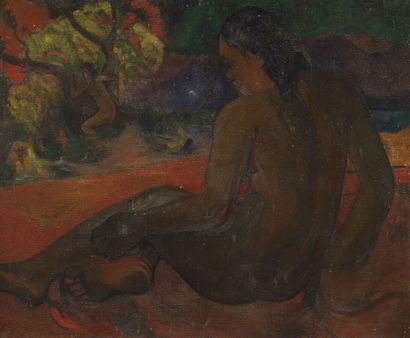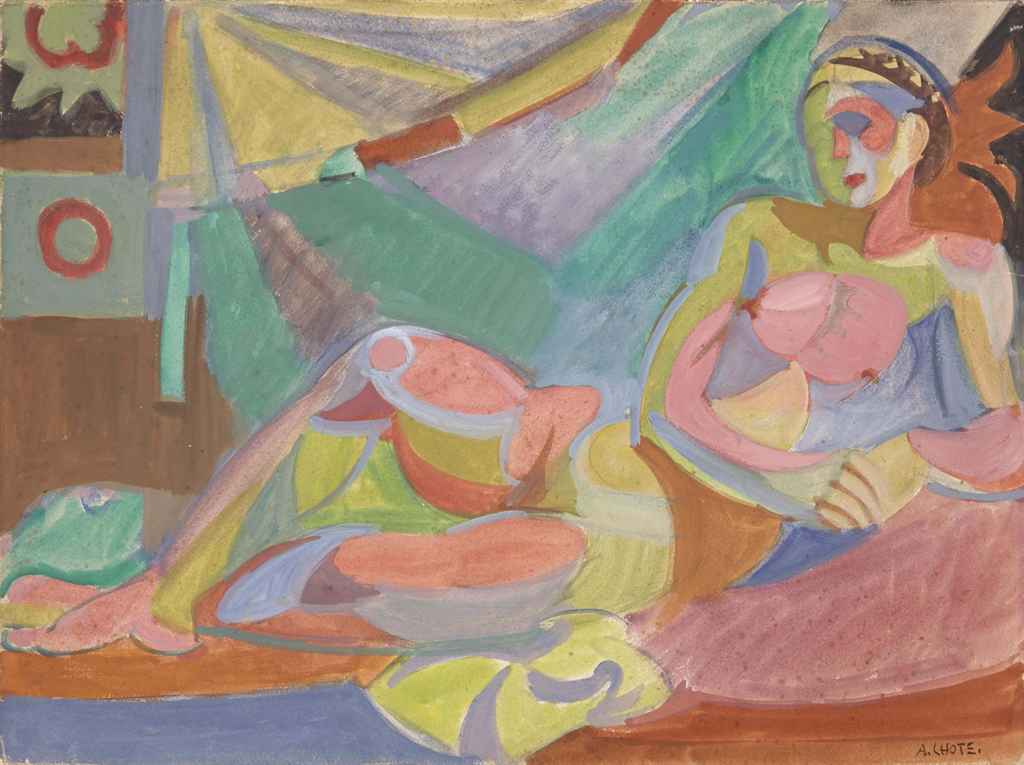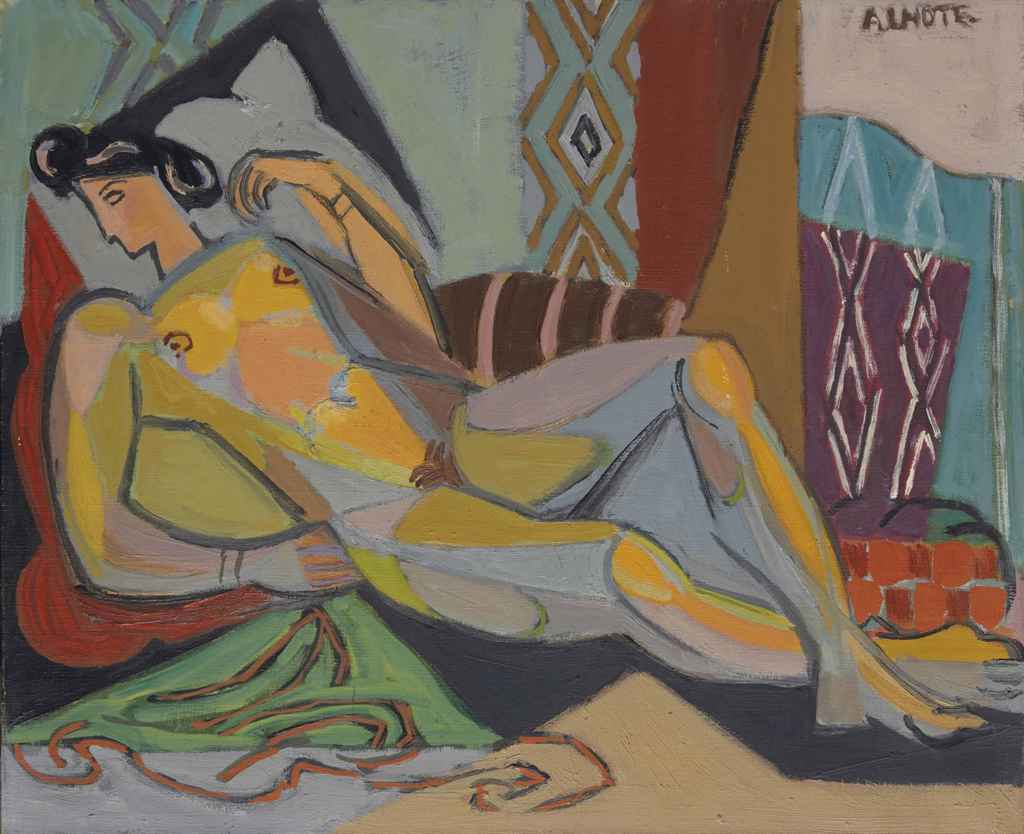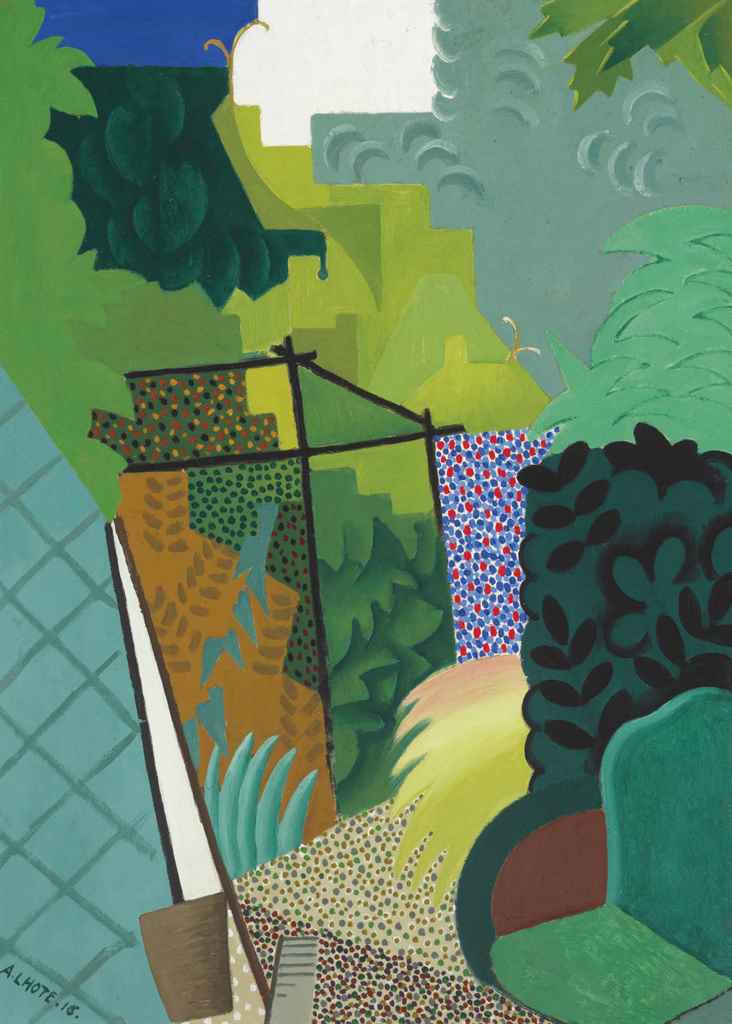Details
André Lhote (1885-1962)
Baigneuses
signé 'A. LHOTE.' (en bas à droite)
huile et fusain sur papier marouflé sur toile
130.5 x 205.5 cm.
Exécuté en 1935
signed 'A. LHOTE.' (lower right)
oil and charcoal on paper laid down on canvas
51 3/8 x 80 7/8 in.
Executed in 1935
Provenance
Atelier de l'artiste.
Puis par descendance au propriétaire actuel.
Special Notice
Artist's Resale Right ("droit de Suite").
If the Artist's Resale Right Regulations 2006 apply to this lot, the buyer also agrees to pay us an amount equal to the resale royalty provided for in those Regulations, and we undertake to the buyer to pay such amount to the artist's collection agent.
This item will be transferred to an offsite warehouse after the sale. Please refer to department for information about storage charges and collection
details.
Post Lot Text
" Il est fascinant de saisir un spectacle en mouvement en le figeant dans sa phase cruciale, […] à ce moment où, comme un pendule au bout de sa trajectoire, tout semble s'immobiliser une seconde avant de repartir en éclairs rapides"
André Lhote cité in A. Jakovsky, André Lhote 48 reproductions commentées par le peintre, Paris, 1947, p. 251-267.
Né à Bordeaux en 1885, André Lhote s’oriente très jeune vers la pratique artistique en se formant, dès ses treize ans, à la sculpture sur bois dans l'atelier d'un fabricant de meubles, puis à l'École des Beaux-Arts. Agé de vingt ans, l’artiste, qui pratiquait principalement la sculpture, quitte le domicile familial pour s’installer dans son propre atelier, à Paris. C’est là qu’il se tourne vers la peinture ; talentueux, le jeune Lhote se fait rapidement une place au sein de la scène artistique parisienne. En 1910, la Galerie Druet lui consacre déjà sa première exposition personnelle. Développant un nouveau style pictural, l’artiste s’intéresse de plus en plus à l’aspect théorique de la peinture. Il fonde d’ailleurs la "Nouvelle Revue Française", dans laquelle il publiera ses considérations critiques sur l'art, jusqu'en 1940. Sa première participation au Salon d’Automne de 1907 et sa participation à la « Section d’Or » en 1912 lui confèrent rapidement une renommée internationale. L’artiste ne cesse alors de faire évoluer son style, se rapprochant des cubistes à l'instar de Robert Delaunay Jean Metzinger et Fernand Léger La réputation internationale acquise, André Lhote créé sa propre académie d’art en 1925. Très influente, elle est alors considérée comme l'une des principales écoles modernes de Paris. Son enseignement met l'accent sur des thèmes chers aux yeux de Lhote : la composition picturale, la simplification des formes en une géométrie de base et l'utilisation de la couleur pour intégrer les formes, tout en tenant compte des leçons de l'art européen traditionnel.
La présente composition peinte en 1935, atteste elle aussi des préoccupations artistiques de Lhote. Ces Baigneuses démontrent magnifiquement la volonté du peintre de souligner la taille monumentale de son tableau. Ce sujet des Baigneuses est aussi pour le peintre l’occasion d’évoquer la tradition de l’art mural tandis que les dispositifs cubistes formels en font une peinture du XXe siècle tout à fait moderne. Comme de nombreux artiste des années 1920’, Lhote tient compte du rappel à l'ordre invoqué par Jean Cocteau qui exhorte les artistes à mettre en avant les valeurs humanistes dans l'art après les violents bouleversements de la première guerre mondiale. La présente œuvre atteste en outre de l’intérêt de Lhote pour la forme et la couleur: ici les arabesques et les couleurs se répondent, créant un rythme et une harmonie, accentuées par l’importance accordée au nombre d’or. La couleur, précise et non modulée, bien qu'adoucie, est peinte avec une superbe sensibilité. Le jeu audacieux des lignes et des superpositions ainsi que la juxtaposition complexe de plans et d'éléments figuratifs géométriques, confèrent quant à eux une inventivité à la construction formelle. Enfin, si cette œuvre est aussi emblématique du travail d’André Lhote c’est parce qu’elle témoigne de la place centrale qu’occupe le travail sur papier dans l’œuvre de l’artiste (voir André Lhote Le Traité du Paysage, Paris, 1939, p. 74) . Ces Baigneuses traduisent ainsi le style pictural post-cubiste unique d’André Lhote : une vision triomphante et spontanée alliant une utilisation sans retenue de couleurs vives aux idées formelles du cubisme. Débordante d'énergie, cette œuvre reprend un thème maintes fois utilisé dans l’Histoire de l’Art, rendant grâce aux nus voluptueux des grands maitres, atteignant une monumentalité classique. Or, ici, Lhote y ajoute les codes cubistes pour insuffler à son œuvre une qualité vivante et résolument moderne qui lui est propre.
“I find it fascinating to capture a moving spectacle by freezing it at its crucial phase, […] at the very instant when, like a pendulum at the end of its trajectory, everything seems to become motionless for a second before taking off again in rapid sparks”
André Lhote quoted in A. Jakovsky, André Lhote 48 reproductions commentées par le peintre, Paris, 1947, p. 251-267.
Born in Bordeaux in 1885, André Lhote was just thirteen when he launched his artistic career, joining the workshop of a furniture manufacturer as a trainee wood carver, before studying at the École des Beaux-Arts. At the age of twenty, the artist, who had mainly focused on sculpture up to this point, left the family home and moved into his own studio in Paris. It was here that he turned to painting and, thanks to his talent, the young Lhote rapidly made a name for himself on the Paris art scene. In 1910, the celebrated Druet gallery was already hosting Lhote’s first solo exhibition. Developing a new pictorial style, the artist became increasingly interested in the theory of painting, founding the “Nouvelle Revue Française”, where he published his critical observations on art until 1940. After his work was included in the Salon d’Automne of 1907 and selected for the “Section d’Or” in 1912, he rapidly rose to prominence on the international scene. The artist then continued to hone his style, drawing closer to Cubists such Robert Delaunay Jean Metzinger and Fernand Léger After establishing his international reputation, André Lhote set up his own art academy in 1922. Highly influential, it was considered one of the leading schools of modern art in Paris. His teaching placed an emphasis on the things Lhote held in highest regard: pictorial composition, the simplification of shapes into basic geometry and the use of colour to incorporate forms, while reflecting the lessons learnt from traditional European art. The Baigneuses, painted in 1935, also attests to Lhote’s interests as an artist. It is a wonderful demonstration of his desire to give prominence to the academic reasoning from which iconoclastic modern artists had distanced themselves. The monumental size and subject of this work reference the academic tradition of large genre paintings, while the formal Cubist devices make it a thoroughly modern 20th-century painting.
Like many post-war artists, Lhote was mindful of Jean Cocteau’s appeal to artists to foreground humanist values in art after the violent upheaval of the First World War. This work also attests to Lhote’s interest in shapes and colours, with its arabesques echoing the colours to create rhythm and harmony, brought into sharper focus by his emphasis on the golden ratio. Although softened, the colour is sharp and unmodulated, and painted with a wonderful sensibility. The bold interplay of lines and superpositions and the complex juxtaposition of planes and geometric figurative components gives the formal construction an inventive dimension. Lastly, this painting is emblematic of the work of André Lhote because it reveals the central role played by work on paper in the artist’s oeuvre (see André Lhote Le Traité du Paysage, Paris, 1939, p.7 4). The Baigneuses translates André Lhote’s unique Cubist pictorial style, with its triumphant and spontaneous vision combining the uninhibited use of vivid colours with the formal ideas of Cubism. Bursting with energy, this work explores a subject used repeatedly in the history of art, paying tribute to the voluptuous nudes of the great masters to achieve a monumentality of classic proportions. Here, however, Lhote introduces Cubist conventions to infuse his work with a vibrant and resolutely modern quality all of his own.
Details
André Lhote (1885-1962)
Baigneuses
signé 'A. LHOTE.' (en bas à droite)
huile et fusain sur papier marouflé sur toile
130.5 x 205.5 cm.
Exécuté en 1935
signed 'A. LHOTE.' (lower right)
oil and charcoal on paper laid down on canvas
51 3/8 x 80 7/8 in.
Executed in 1935
Provenance
Atelier de l'artiste.
Puis par descendance au propriétaire actuel.
Special Notice
Artist's Resale Right ("droit de Suite").
If the Artist's Resale Right Regulations 2006 apply to this lot, the buyer also agrees to pay us an amount equal to the resale royalty provided for in those Regulations, and we undertake to the buyer to pay such amount to the artist's collection agent.
This item will be transferred to an offsite warehouse after the sale. Please refer to department for information about storage charges and collection
details.
Post Lot Text
" Il est fascinant de saisir un spectacle en mouvement en le figeant dans sa phase cruciale, […] à ce moment où, comme un pendule au bout de sa trajectoire, tout semble s'immobiliser une seconde avant de repartir en éclairs rapides"
André Lhote cité in A. Jakovsky, André Lhote 48 reproductions commentées par le peintre, Paris, 1947, p. 251-267.
Né à Bordeaux en 1885, André Lhote s’oriente très jeune vers la pratique artistique en se formant, dès ses treize ans, à la sculpture sur bois dans l'atelier d'un fabricant de meubles, puis à l'École des Beaux-Arts. Agé de vingt ans, l’artiste, qui pratiquait principalement la sculpture, quitte le domicile familial pour s’installer dans son propre atelier, à Paris. C’est là qu’il se tourne vers la peinture ; talentueux, le jeune Lhote se fait rapidement une place au sein de la scène artistique parisienne. En 1910, la Galerie Druet lui consacre déjà sa première exposition personnelle. Développant un nouveau style pictural, l’artiste s’intéresse de plus en plus à l’aspect théorique de la peinture. Il fonde d’ailleurs la "Nouvelle Revue Française", dans laquelle il publiera ses considérations critiques sur l'art, jusqu'en 1940. Sa première participation au Salon d’Automne de 1907 et sa participation à la « Section d’Or » en 1912 lui confèrent rapidement une renommée internationale. L’artiste ne cesse alors de faire évoluer son style, se rapprochant des cubistes à l'instar de Robert Delaunay Jean Metzinger et Fernand Léger La réputation internationale acquise, André Lhote créé sa propre académie d’art en 1925. Très influente, elle est alors considérée comme l'une des principales écoles modernes de Paris. Son enseignement met l'accent sur des thèmes chers aux yeux de Lhote : la composition picturale, la simplification des formes en une géométrie de base et l'utilisation de la couleur pour intégrer les formes, tout en tenant compte des leçons de l'art européen traditionnel.
La présente composition peinte en 1935, atteste elle aussi des préoccupations artistiques de Lhote. Ces Baigneuses démontrent magnifiquement la volonté du peintre de souligner la taille monumentale de son tableau. Ce sujet des Baigneuses est aussi pour le peintre l’occasion d’évoquer la tradition de l’art mural tandis que les dispositifs cubistes formels en font une peinture du XXe siècle tout à fait moderne. Comme de nombreux artiste des années 1920’, Lhote tient compte du rappel à l'ordre invoqué par Jean Cocteau qui exhorte les artistes à mettre en avant les valeurs humanistes dans l'art après les violents bouleversements de la première guerre mondiale. La présente œuvre atteste en outre de l’intérêt de Lhote pour la forme et la couleur: ici les arabesques et les couleurs se répondent, créant un rythme et une harmonie, accentuées par l’importance accordée au nombre d’or. La couleur, précise et non modulée, bien qu'adoucie, est peinte avec une superbe sensibilité. Le jeu audacieux des lignes et des superpositions ainsi que la juxtaposition complexe de plans et d'éléments figuratifs géométriques, confèrent quant à eux une inventivité à la construction formelle. Enfin, si cette œuvre est aussi emblématique du travail d’André Lhote c’est parce qu’elle témoigne de la place centrale qu’occupe le travail sur papier dans l’œuvre de l’artiste (voir André Lhote Le Traité du Paysage, Paris, 1939, p. 74) . Ces Baigneuses traduisent ainsi le style pictural post-cubiste unique d’André Lhote : une vision triomphante et spontanée alliant une utilisation sans retenue de couleurs vives aux idées formelles du cubisme. Débordante d'énergie, cette œuvre reprend un thème maintes fois utilisé dans l’Histoire de l’Art, rendant grâce aux nus voluptueux des grands maitres, atteignant une monumentalité classique. Or, ici, Lhote y ajoute les codes cubistes pour insuffler à son œuvre une qualité vivante et résolument moderne qui lui est propre.
“I find it fascinating to capture a moving spectacle by freezing it at its crucial phase, […] at the very instant when, like a pendulum at the end of its trajectory, everything seems to become motionless for a second before taking off again in rapid sparks”
André Lhote quoted in A. Jakovsky, André Lhote 48 reproductions commentées par le peintre, Paris, 1947, p. 251-267.
Born in Bordeaux in 1885, André Lhote was just thirteen when he launched his artistic career, joining the workshop of a furniture manufacturer as a trainee wood carver, before studying at the École des Beaux-Arts. At the age of twenty, the artist, who had mainly focused on sculpture up to this point, left the family home and moved into his own studio in Paris. It was here that he turned to painting and, thanks to his talent, the young Lhote rapidly made a name for himself on the Paris art scene. In 1910, the celebrated Druet gallery was already hosting Lhote’s first solo exhibition. Developing a new pictorial style, the artist became increasingly interested in the theory of painting, founding the “Nouvelle Revue Française”, where he published his critical observations on art until 1940. After his work was included in the Salon d’Automne of 1907 and selected for the “Section d’Or” in 1912, he rapidly rose to prominence on the international scene. The artist then continued to hone his style, drawing closer to Cubists such Robert Delaunay Jean Metzinger and Fernand Léger After establishing his international reputation, André Lhote set up his own art academy in 1922. Highly influential, it was considered one of the leading schools of modern art in Paris. His teaching placed an emphasis on the things Lhote held in highest regard: pictorial composition, the simplification of shapes into basic geometry and the use of colour to incorporate forms, while reflecting the lessons learnt from traditional European art. The Baigneuses, painted in 1935, also attests to Lhote’s interests as an artist. It is a wonderful demonstration of his desire to give prominence to the academic reasoning from which iconoclastic modern artists had distanced themselves. The monumental size and subject of this work reference the academic tradition of large genre paintings, while the formal Cubist devices make it a thoroughly modern 20th-century painting.
Like many post-war artists, Lhote was mindful of Jean Cocteau’s appeal to artists to foreground humanist values in art after the violent upheaval of the First World War. This work also attests to Lhote’s interest in shapes and colours, with its arabesques echoing the colours to create rhythm and harmony, brought into sharper focus by his emphasis on the golden ratio. Although softened, the colour is sharp and unmodulated, and painted with a wonderful sensibility. The bold interplay of lines and superpositions and the complex juxtaposition of planes and geometric figurative components gives the formal construction an inventive dimension. Lastly, this painting is emblematic of the work of André Lhote because it reveals the central role played by work on paper in the artist’s oeuvre (see André Lhote Le Traité du Paysage, Paris, 1939, p.7 4). The Baigneuses translates André Lhote’s unique Cubist pictorial style, with its triumphant and spontaneous vision combining the uninhibited use of vivid colours with the formal ideas of Cubism. Bursting with energy, this work explores a subject used repeatedly in the history of art, paying tribute to the voluptuous nudes of the great masters to achieve a monumentality of classic proportions. Here, however, Lhote introduces Cubist conventions to infuse his work with a vibrant and resolutely modern quality all of his own.




.jpg)
.jpg)
.jpg)

.jpg)
.jpg)

.jpg)
.jpg)


Try LotSearch and its premium features for 7 days - without any costs!
Be notified automatically about new items in upcoming auctions.
Create an alert